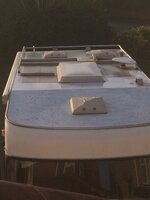jo10000_6
Free Member
Hi all
My head really hurts - I feel I'm going around in circles and getting no where which annoys me greatly and as mentioned makes my head hurt.
I've posted a few times recently on :
My charger capabilities - Answer not great 7.2A charger
How long did my battery last - Answer not as long as it should
2nd Leisure Battery recommendations - Answer need better than last time
Battery Monitor - Yes Id like one
Questions on Solar - yes Id like it but do I need it.
Every time I feel I'm getting somewhere I take a step or 2 steps back and its all about making sure I make the right decisions - in the right order and for the right reasons.
All I want is a little more off grid time - not loads - 4 / 5 days Maximum.
My previous posts tell me my one battery wont do this.
My 7.2 Amp Charger will struggle
I don't have a proper split relay system although there's a crude wiring system to connect to get me out of trouble.
I was all for getting a second battery - treating myself to a battery monitor to feed my obsessions - getting them wired in together - getting the split charge sorted and having a new charger and in theory being ok until I read a an old post just earlier to say a fellow funster had a old Hymer only to find the split charge system for 2 leisure batteries and one cab battery that the alternator wasn't big enough. Another post said make sure when changing the charger that the wiring is big enough for the bigger charger.
See, backward steps all the time.
Which begs the question should I stick with one battery and pursue solar ? My roof is busy not sure what Id fit up there but the above is getting complicated by the second.
I honestly try and do the research but I'm feeling very dejected with the answers I find.
Tomorrow I will jump out of bed with a new lease of life but tonight I feel I've taken on more than I can chew.
My head really hurts - I feel I'm going around in circles and getting no where which annoys me greatly and as mentioned makes my head hurt.
I've posted a few times recently on :
My charger capabilities - Answer not great 7.2A charger
How long did my battery last - Answer not as long as it should
2nd Leisure Battery recommendations - Answer need better than last time
Battery Monitor - Yes Id like one
Questions on Solar - yes Id like it but do I need it.
Every time I feel I'm getting somewhere I take a step or 2 steps back and its all about making sure I make the right decisions - in the right order and for the right reasons.
All I want is a little more off grid time - not loads - 4 / 5 days Maximum.
My previous posts tell me my one battery wont do this.
My 7.2 Amp Charger will struggle
I don't have a proper split relay system although there's a crude wiring system to connect to get me out of trouble.
I was all for getting a second battery - treating myself to a battery monitor to feed my obsessions - getting them wired in together - getting the split charge sorted and having a new charger and in theory being ok until I read a an old post just earlier to say a fellow funster had a old Hymer only to find the split charge system for 2 leisure batteries and one cab battery that the alternator wasn't big enough. Another post said make sure when changing the charger that the wiring is big enough for the bigger charger.
See, backward steps all the time.
Which begs the question should I stick with one battery and pursue solar ? My roof is busy not sure what Id fit up there but the above is getting complicated by the second.
I honestly try and do the research but I'm feeling very dejected with the answers I find.
Tomorrow I will jump out of bed with a new lease of life but tonight I feel I've taken on more than I can chew.


